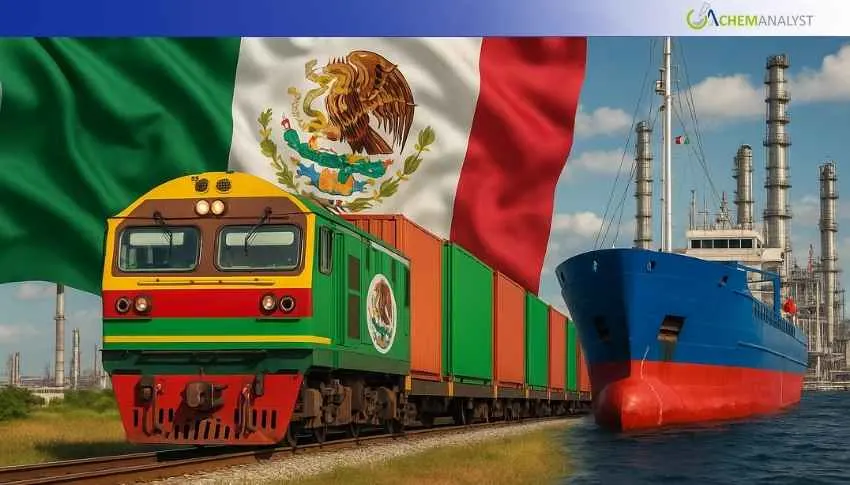Welcome To ChemAnalyst

The Interoceanic Corridor of Mexico is rapidly emerging as a lifeline for both global trade and local development. The Corridor spans 300 km, between Salina Cruz and Coatzacoalcos, giving shippers an alternative and faster, more reliable route to the Panama Canal, especially during droughts or delays with the Panama Canal. The corridor serves a logistical purpose, but it also has profound social value, creating jobs, developing industrial clusters, and providing opportunity for communities in which poverty is high. By 2028, it may have the capacity to move 300,000 containers a year, constantly changing the future of southern Mexico.
Mexico is making significant progress with its Interoceanic Corridor of the Isthmus of Tehuantepec, a major infrastructure project that will redefine global trade and foster development in southern Mexico. Originally developed in 1907, the corridor is being improved for a modern revitalization under the direction of President Claudia Sheinbaum. The corridor is a 300-kilometer rail line that links the Pacific port of Salina Cruz in Oaxaca to the Gulf port of Coatzacoalcos in Veracruz. Salina Cruz and Coatzacoalcos will be rebuilt as ports in a major expansion and revitalization effort. There will be new industrial parks and twelve development hubs, with the entire system expected to be operational by next year.
The timing of this project is relevant when the Panama Canal, the dominant route for travel between the Atlantic and Pacific oceans, is experiencing difficult times: drought has reduced the number of ships passing through the canal, and geopolitical tensions are raising concerns over control of key maritime routes. Mexico's Corridor provides an alternative using land methods: cargo is unloaded one coast, then transported by train across the isthmus, and then reloaded at the other port. Although this alternative involves more cargo handling, it can save several days when the canal is congested, it is a good option for the shipper to have when the Canal is out of service.
The reason given above is an obvious backup plan for shippers when the canal stops operating or slows down as the volume of traffic in today's economy suggests. Also, ships from one side of the coast to the other avoid customs inspection altogether if the cargo is unloaded at one port and reloaded at the second port, saving time at customs while addressing situational issues with delays.
In early April, Mexico successfully transported 900 Hyundai automobiles from Salina Cruz to Coatzacoalcos. This milestone was a significant step in demonstrating operational readiness for the development of the Interoceanic Corridor. The test run indicated Mexico was ready for regular operations and those operations will be funded primarily by public investment. Mexico targets its corridor for success, seeing the life of the south, the logistics economies to foster development in Latin America, business attraction, job provision, etc., is targeted in many solutions by these investments; improved infrastructure is part of this strategy particularly in regions where people live in poverty. Approximately 60% of all people living near the corridor are estimated to either be living in poverty or extreme poverty. The hope for change by the officials is considerable because of the new infrastructure project.
The speed of the corridor's operations is of utmost impact on the development options. The Panama Canal transit time, for example, can take 8 - 24 hours based on traffic; the CIIT railroad leg to Coatzacoalcos takes less than six hours. The delays at the canal give shippers options while maintaining flexibility, particularly where climate issues affect shipping routes. The efficiency of the transportation along the corridor has entered space in the pandemic landscape, including some sufficiency, and whitecapped the excitement for the heavy play return.
According to the experts, the container importation/transshipment International Interoceanic Corridor (CIIT) will not replace the Panama Canal, which welcomes more than 8 million containers and 14,000 ships annually. However, CIIT can contribute in this manner, relieving overflow traffic and providing a viable alternative. This will be contingent upon the ports operating efficiently; being able to leverage significant rail capacity; the transport of recyclable containers directed to the United States or Canada; and cooperation with other affiliated nations (especially the United States and China). Trade policies and global demand for commodities will also have an influence, especially as it relates to costs.
As it stands, by 2028 the corridor is projected to generate roughly 300,000 containers annually and will rise to 1.4 million by 2033. This could constitute as much as 17% of the Panama Canal's current flow, but again, we will see shifts only in relation to whether the ports and logistics perform.
From a diplomatic perspective, Mexico and Panama are working to forge ahead without conflict. Panama's Ambassador stated recently that the two journeys are complementary, not competing. President Sheinbaum shared this line of thought, announcing that Guatemala will build its own section so that it will connect with Mexico's Line K (part of the larger Interoceanic Corridor) by 2026, better separating Central America from such maritime or land-locked traffic.
As Q3 progresses, the CIIT should expect more pilot shipments, improved rail and ports, and consistent growth. It may not eclipse the Panama Canal, but it is emerging as a viable alternative - a reliable option for when time, risk, or capacity dictate that the land bridge is the better option. With supply chains constantly strained, Mexico's Interoceanic Corridor is providing a timely and strategic solution.
We use cookies to deliver the best possible experience on our website. To learn more, visit our Privacy Policy. By continuing to use this site or by closing this box, you consent to our use of cookies. More info.
